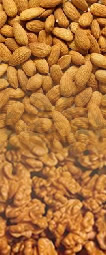
The walnut is one of the world's most venerable foods. In Périgord (the region in Southwest France), from Peyrat to Terrasson, excavations have brought to light petrified shells of nuts that were roasted during the Neolithic period, more than eight thousand years ago.
Around 2000 B.C. in Mesopotamia, the Chaldeans left inscriptions on clay tablets revealing the existence of walnut groves within the famed Hanging Gardens of Babylon. There is evidence of walnut consumption dating from the same era on carved steal containing the Code of Hammurabi in a section devoted to food.
The walnut appears in Greek mythology in the story of Carya, with whom the god Dionysus fell in love. When she died, Dionysus transformed her into a walnut tree. The goddess Artemis carried the news to Carya's father and commanded that a temple be built in her memory. Its columns, sculpted in wood in the form of young women, were called catyatides, or nymphs of the walnut tree.
The very name of the walnut tree and its nut comes down to us from the Romans. Juglans regia (walnut tree) and nux juglandes (the walnut) stem from Jovis Glans or the Royal Nut of Jove. The word for nut itself derives from the Latin nux or nucleus (fruit of the shell), with a suggested derivation from nox (night) owing to the dark juice of the nut, which was used to dye wool.
The walnut and the oil extracted from it, therefore, have been known since ancient times. Theory has it that the walnut may have disappeared in parts of northern Europe during the glacial period but was then reintroduced by barbarian invaders and by Greco-Roman conquerors. Once the tree was reestablished, the exploitation of its products spread steadily through increasing trade.
Source: The Walnut Cookbook, Jean-Luc Toussaint


About Walnuts
There are 37 varieties of walnuts grown in California. However, four varieties account for over 80 per cent of total production: Chandler, Hartley, Payne and Serr.
Chandler
Harvest mid-season; large smooth oval nut, with good shell seal and high quality kernel. Kernel colour is excellent, light grade consistently 90 per cent or better. Has potentially high fruitfulness with 80 to 90 per cent of lateral buds fruitful. Medium size tree is a moderately vigorous and semi-upright, highly productive tree. Pollinizers are Cisco and Scharsch Franquette.
Chico
Small, upright, early harvest, highly productive tree. Nut size is small with excellent kernel quality. Due to smaller size trees and a very high percentage of lateral pistil late; bloom 90 to 100 per cent. It is well suited for high-density plantings. Pollinizers are Payne, Serr or Sunland.
Cisco
Its main attribute is as a pollinizer for Chandler and Howard. In growth habits Cisco is semi-upright and a small tree..
Eureka
Tree is very large, somewhat spreading growth habit. Harvest early to mid-season. Nut is medium size elongated with a good shell seal.
Franquette
A late leafing Californian variety which is good for areas with late spring frosts. Unfortunately, its late flowering also means it misses the pollen shed by other varieties, so nut set and yields are often poor. It may be worth trying 'Mayrick,' also late flowering, as a pollinizer or 'Rex.’ Most Californian varieties are susceptible to walnut blight, and are therefore poorly suited to wet and humid areas, but Franquette seems to have some degree of blight resistance. Franquette is a terminal bearer. The nuts are large, and attractive. Crack out is around 31 per cent. Franquette reputedly also has very high quality timber.
Hartley
Percentage of light kernels nearly 90 per cent. Tree size is moderate to large, moderately spreading with good vigor on fertile soil. Hartley needs 40 to 45 foot spacing for mature tree. Most widely planted walnut variety in California. Acceptable pollinizers are the late blooming Amigo and Scharsch Franquette.
Howard
Harvest mid-season; nut is large, round and smooth with a good seal. Kernel quality is excellent at 90 per cent light, and kernel percentage is 50 per cent. Tree size is small to medium and semi-upright with moderate vigor, which makes it a good candidate for high-density plantings. Pollinizers are Cisco or Scharsch Franquette.
Payne
Harvested early in the season. Payne nut size is medium to small. Shell seal is very good. Nuts average 48 per cent kernel with approximately 50 per cent light. Yield potential is high to very high. Approximately 80 per cent to 90 per cent of the lateral buds on shoots are fruitful. Very productive. Tree is medium round shaped. Heavy pruning is required when trees are young to avoid overbearing.
Pedro
A particularly desirable walnut for the home gardener because it is a relatively 'small' tree at about nine metres/30 feet high. It is self fertile, needing 400 hours of winter chill (not suited to areas with late frost), and the nut is both well sealed and particularly liked when tested in consumer taste panels.
Serr
Harvest is early to mid-season. Nut size is large, with a fair to good shell seal. Kernel is 60 per cent light. Percentage of kernel is high at 59 per cent. Serr planted on shallower, heavier, or less fertile soil seems to bear better. Serr tree size is large and requires a spacing of at least 40 feet. Shape is moderately spreading and vigor is good to excessive. Suitable pollinizers include Chico and Tehama.
Tulare
Harvest mid-season. The nut and kernel are large, with a well-sealed, nearly round nut. The Tulare requires no pollinizer. Tree has upright growth habit, moderately vigor, suitable for hedgerow and other high-density planting systems.
Vina
Harvest early to mid-season; medium size pointed nut, with a good shell seal. Kernel color is good at 60 per cent light with 48 per cent kernel. Tree size is small to medium; vigor is moderate to good and highly productive. Pollinizers are Chico, Chandler, Howard and Tehama.
Source: The Walnut Marketing Board; http://www.walnuts.org
California Walnut Varieties
Walnut History
Nutrition Facts
Don't be fooled by their small size. California Walnuts are packed with good nutrition. As well as featuring cholesterol-lowering properties, they contain other heart-healthy components such as vitamin E and dietary fibre. Visit our Nutrition/Health section for more information.
Don't be fooled by their small size. California Walnuts are packed with good nutrition. As well as featuring cholesterol-lowering properties, they contain other heart-healthy components such as vitamin E and dietary fibre. Visit our Nutrition/Health section for more information.
The delectable walnut ranks as one of the most widely consumed nuts in the world. Inside a tough shell, its curly nutmeat halves offer a rich, sweet flavor, and the edible papery skin adds a hint of bitterness. California produces the highest-quality English walnuts in the world; its crop accounts for 98 percent of the U.S. market and approximately 40 percent of the world market.
Walnuts are a great source of protein and fiber. They also contain significant amounts of thiamin, vitamin B6, folacin and vitamin E. Other mineral value comes from iron, zinc, copper, magnesium, phosphorus and potassium. Their high percentage of omega-3 fatty acids helps make walnuts “heart-friendly.” See Healthy Living for more on “Essential Omega-3s.”
Shelled walnuts should be kept in an odor free as well as ammonia free environment away from excessive heat, moisture, light and air to ensure maximum shelf life. To maintain optimum freshness, shelled walnut kernels should be kept in refrigerated storage areas at 0-3.3 degrees C or 32-38 degrees F, and at 55-65% relative humidity.
Source: Walnut Marketing Board of CA

